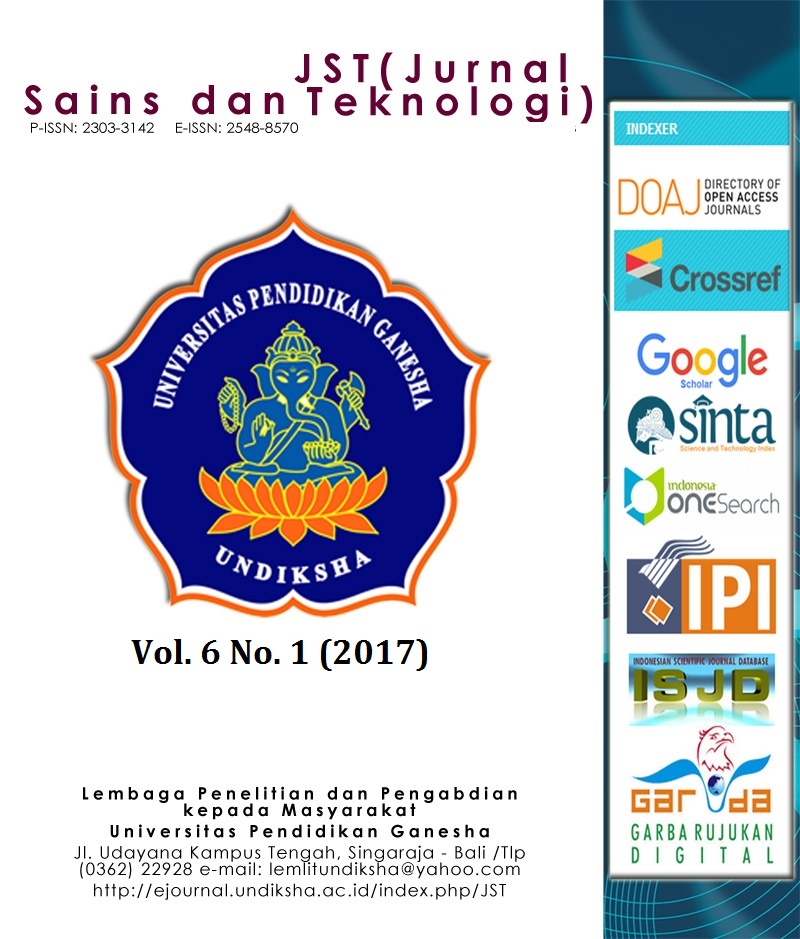UJI EFEKTIVITAS LARVASIDA DAUN MIMBA (Azadirachta indica) TERHADAP LARVA LALAT Sarcophaga PADA DAGING UNTUK UPAKARA YADNYA DI BALI
DOI:
https://doi.org/10.23887/jstundiksha.v6i1.9233Keywords:
daun mimba, lalat daging, larvasidaAbstract
Cara mengusir lalat daging pada sarana upacara yadnya di Bali belum efektif, sehingga diperlukan cara alternatif menggunakan daun mimba (Azadirachta indica). Tujuan penelitian ini untuk mendeskripsikan efektivitas larvasida daun mimba terhadap larva lalat Sarchopaga pada daging yang digunakan sebagai sarana upakara di Bali. Kelompok perlakuan ini yaitu penggunaan daun mimba 25% sebagai larvasida, kelompok kontrol positif yaitu penggunaan minuman bersoda, dan kelompok kontrol negatif yaitu tidak mendapat perlakuan. Hasil uji Kruskal Wallis diperoleh hasil nilai probabilitas p (0,000) < α (0,05) yang menunjukkan adanya perbedaan jumlah kematian larva pada perlakuan rebusan daun mimba 25 %, kontrol negatif dan kontrol positif. Perlakuan daun mimba konsentrasi 25% memberikan jumlah kematian larva yang lebih tinggi dibandingkan terhadap kontrol positif dengan perbedaan persentase sebesar 60%. Daun mimba lebih efektif sebagai larvasida jika dibandingkan dengan minuman bersoda. Perebusan daging dengan menambahkan daun mimba dapat digunakan untuk menghindari pembusukan yang disebarkan oleh lalat daging (Sarchopaga).
References
Biswas, K., Chattopadhyay, I., Banerjee, R. K., & Bandyopadhyay, U. (2002). Biological activities and medicinal properties of neem (Azadirachta indica). Current Science, 82(11), 1336–1345.
Byrd, J. H., & Castner, J. L. (2001). Insects of Forensic Importance in Forensic Entomology: The Utility of Arthropods in Legal Investigation. New York: CRC Press.
Chandra, B. (2005). Pengantar Kesehatan Lingkungan. Jakarta: Penerbit Buku Kedokteran (EGC).
David, B.V., Anathakrishnan, T. N. (2004). General and Applied Entomology. New Delhi: Tata Mc Graw - Hill Companies.
Fathoni, M., Yanuwiadi, B., & Leksono, A. S. (2013). The effectiveness of combination Mahogany (Swietenia mahogany) seed and Sour Sup (Annona muricata) leaf pesticide to the time of stop feeding and LC50 mortality on armyworm (Spodoptera litura F.). Journal of Biodiversity and Environmental Sciences (JBES), 3(11), 71–77.
Graczyk, T. K., Knight, R., & Tamang, L. (2005). Mechanical Transmission Of Human Protozoan Parasites By Insects. Clinical Microbiology Reviews, 18(1), 128–132.
Hariana, A. (2013). Tumbuhan Obat dan Khasiatnya. Jakarta: Penebar Swadaya.
Kardinan, A. (2000). Pestisida nabati, Ramuan dan Aplikasi. Jakarta: Penebar Swadaya.
Mordue (Luntz), A. J., Simmonds, M. S. J., Ley, S. V., Blaney, W.M. , Mordue, W., Nasiruddin, M., & Nisbet, A. J. (1998). Actions of azadirachtin, a plant allelochemical, against insects. Pesticide Science, 54(3), 277–284.
Pritima, R.A., Pandian, R. S. (2008). Antibacterial Potency of Crude Extract of Azadirachta indica A. Juss (Leaf) Against Mirobes Causing Reproductive Tract Infections Among Women. Current Biotika, 2, 2–6.
Samsudin. (2011). Biosintesa dan cara kerja azadirachtin sebagai bahan aktif insektisida nabati. Semnas Pesnab IV, 61–70.
Santi, D. N. (2001). Manajemen Pengendalian Lalat. Fakultas Kedokteran Universitas Sumatera Utara.
Sudarsana, I. P. . (2010). Himpunan Tetandingan Upakara Yadnya. Denpasar: Percetakan Bali.
Susanti, N. D., Sukesi, T. W., & Soeyoko. (2012). Efektivitas Ekstrak Etanol Daun Mimba(Azadirachta Indica A. Juss) Sebagai Larvasida Terhadap Larva Aedes Aegypti, 46–53.
Downloads
Published
How to Cite
Issue
Section
License
Authors who publish with the Jurnal Sains dan Teknologi (JST) agree to the following terms:
- Authors retain copyright and grant the journal the right of first publication with the work simultaneously licensed under a Creative Commons Attribution License (CC BY-SA 4.0) that allows others to share the work with an acknowledgment of the work's authorship and initial publication in this journal.
- Authors are able to enter into separate, additional contractual arrangements for the non-exclusive distribution of the journal's published version of the work (e.g., post it to an institutional repository or publish it in a book), with an acknowledgment of its initial publication in this journal.
- Authors are permitted and encouraged to post their work online (e.g., in institutional repositories or on their website) prior to and during the submission process, as it can lead to productive exchanges, as well as earlier and greater citation of published work. (See The Effect of Open Access)
















